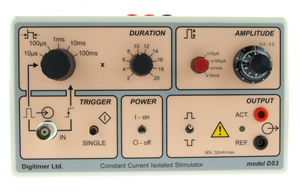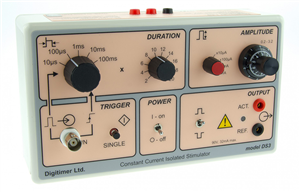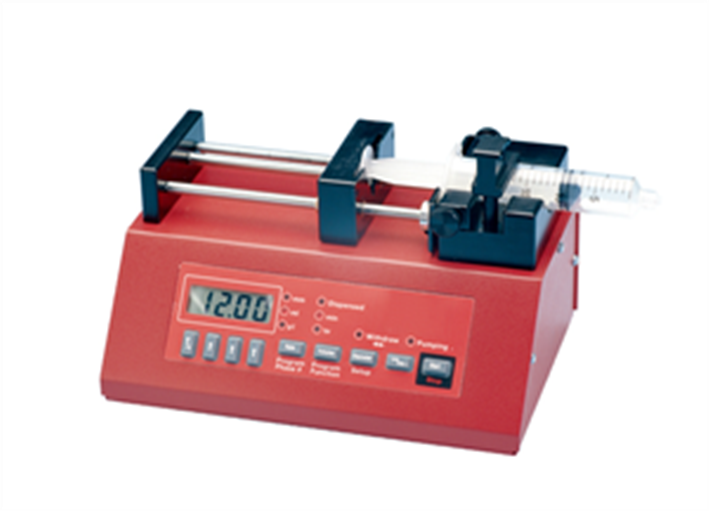

DS3
Isolated Current Stimulator
- Overview
- Specifications
- Accessories
- Citations
- Related Products
Overview
FEATURES
- Low noise battery power supply with 90V compliance
- Internal (20µs to 2s) or external TTL “gated” control of pulse duration
- Four current ranges allow precise reproducible control of stimulus output between 2µA and 32mA
- Polarity reversal switch
- Battery test sockets
The DS3 provides a precise constant current, isolated stimulus, controllable in pulse duration and amplitude from self-contained batteries. The range of pulse durations available can be varied using a six-position switch and multiplier within the range 20 microseconds to 2 seconds as well as being externally controlled (gated). A three-turn dial on the front panel of the stimulator provides a continuous adjustment of the output amplitude which is indicated on the vernier dial as 0.2 to 3.2. With the four ranges (x10μA; x100μA; x1mA and x10mA), currents from 2μA to 32mA can be selected. The existence of an output pulse is indicated by an LED. The Output is optically isolated from the trigger source ensuring a very low capacitive coupling between trigger source and stimulator to reduce artifacts. The self-contained batteries, without a DC-DC converter, ensure that the stimulator is ultra-quiet and does not induce any high-frequency noise into the recording system.
It is worth noting that battery current is only drawn when the stimulator is delivering an output pulse. This greatly extends the life of the batteries. When constant current stimulators are used to stimulate very high-impedance, high capacitance cells the electrode tip can charge up and stimulation be lost. This is because constant current stimulators have a very high output impedance which will not discharge the cells. The DS3 provides an output discharge circuit which operates (if user enabled) after each stimulus pulse. An internal jumper selects this feature.
The DS3 can be triggered by an external device such as our new DG2A Train/Delay Generator. The DS3 can be fitted into a 19″ rack mounting frame (D121-11) which can hold up to two DS3s.
Includes
Operator’s Manual
One set of batteries (fitted)
One Pair of output plugs (NL985P)
FAQ's
I want to stimulate with a longer pulse duration than 2 seconds, in order to lesion some tissue, is it possible to do this?
Yes, there are two simple methods. (i) The DS3 has the ability to be gated by an external pulse i.e. when external control of pulse duration is selected the output stimulus timing will be controlled by the trigger-in stimulus pulse. It should be noted that (with a 5V input pulse) there is only a very short delay of <2µs for the turn-on and <6µs for the turn-off. When a typical TTL pulse is used, which will only be about 3V, these are matched at 4µs each. (ii) Alternatively, if a trigger pulse is not available or exact timing is not crucial (for instance when lesioning or injecting dye, there is a jumper which can be set to allow the unit to deliver a current for the duration the single shot button is held down. The internal SINGLE jumper determines the output delivered when the SINGLE button is pressed (when EXTERNAL Duration is selected). MON (factory setting) produces a very short pulse ~10µs when pressed. CONT produces an active output for the duration of the press. This could be useful in dye marking etc.
Can I control the DS3 or DS2A using a computer?
Yes and no. The DS3 features an external GATE input allowing externally derived trigger pulses to define stimulus duration. However, the output amplitude is always determined by the front panel setting of the stimulator. We recommend our NeuroLog system to those interested in using a computer generated waveform to define stimulus timing/polarity and strength.
I can't decide between the constant current DS3 and constant voltage DS2A MkII- how should I choose?
The visible difference between the two units (apart from the colour!) is that the output control of the DS2A is defined in Volts while the output of the DS3 is defined in Amps. The actual stimulus passing through your preparation is measured in Amps in both cases and is dependent upon Ohms Law (V = IR). If your preparation has a variable impedance (R) and you are using a constant voltage (V) source such as the DS2A, then the actual current (I) passing through the tissue may vary considerably between each stimulus, which may not be a good idea if you want to apply reproducible stimuli. With the DS3, the constant current circuitry prevents variations in tissue impedance from altering the size of current applied (within the 90V compliance limit of the unit), leading to the stimulator equivalent of WYSIWYG ? ?What You Set Is What You Get?. Unfortunately there are no well defined rules governing the circumstances under which either stimulator should be used. If you are not sure and feel the need to evaluate either or both please contact us.
If the DS2A or DS3 is connected to the TTL generating device which is grounded, will the stimulus delivered be still isolated? In other words, would it be safe to use it with patch-clamp, or there is a risk of destroying of the patch-amplifier?
Absolutely. The output of the DS2A or DS3 is optically isolated from the trigger inputs, so there is no need to worry about what your trigger source is, or how it is grounded.
Can the DS2A, DS3 or DS4 be used to stimulate human subjects?
Neither the DS2A, DS3 nor DS4 have medical device directive (MDD) certification and have not been designed for safe human use.
How long do the batteries last for and can I use rechargeable replacements?
Battery life will depend on the frequency of operation and will therefore vary widely with the application, but the following example may be considered typical. Output current ? 20mA, duty cycle ? 1:10, period of operation ? 2 hours/day. Estimated life to end point voltage of 6V per 9V battery ? 2 months. In in vitro electrophysiology applications, the battery life will most likely be far longer as the currents being used will be lower. Replacement batteries should be of premium grade sealed type, alkaline preferred and batteries should not be left in an unused stimulator. Rechargeable batteries are not recommended, as their voltages tend to decline very suddenly, which could lead to a failure in the middle of an experiment.
What is the maximum trigger rate of the DS2A or DS3?
The unit can be triggered fast enough to allow >99% ?on? time, but the ?off? time must >20 microseconds ? so, very fast!
Is it possible to use two DS3 stimulators in parallel in order to stimulate through the same electrodes with different pulse types?
Yes, this is quite simple to setup and has been summarized in an application note
What is the frequency at which the pulses are delivered when the trigger button is pressed in conditions when jumper is set to cont?
The trigger button has no effect of trigger frequency. It is designed to allow the user to press and hold the Trigger Button to deliver a continuous single stimulation pulse while it is held down. This can be useful for electrical lesioning of a recording site once an experiment is complete.
Are any of your stimulators MRI compatible?
Our stimulators are not classed as MRI safe, as all of them contain ferrous materials which means they cannot be used within a magnetic field. However, as long as they are located beyond the reach of magnetic field or in the scanner control room they may be used. It is important that MRI compatible electrodes and cables are used within the scanner room.
Specifications
Output: Output between 2µA and 32mA. Control is achieved by a variable range switch with four selections (10µA, 100µA, 1mA, 10mA) and a three-turn dial. Pulses from high impedance stimulators (constant current units) can result in cells “charging-up” between stimuli, leading to stimulus loss. This problem has been overcome in the DS3, which has an Output Discharge (Clamp) Circuit that operates for 20µs after each stimulus pulse. This will discharge cells with capacitances as high as 1000pF.
Pulse Duration: Range: 20µs to 2s. One dial allows continuous adjustment from 2 to 20, while another is used to select the range (from 10µs, 100µs, 1ms, 10ms, 100ms or external source). Internal pulse duration values have ± 10% accuracy.
Output terminals: A pair of 2mm touch-proof sockets on the front panel spaced at 0.75”.
Polarity Switch: Normal: Red output terminal positive.
Reverse: Red output terminal negative.
Indicator: An LED operates for the duration of each output pulse.
Compliance: 90V from 10 x 9V batteries. This reduces to 87V at the top of each output range. Note that battery voltage will drop from 9V to ~6V with “old” batteries.
Single Shot: A single-shot push button is provided. This operates at all times irrespective of trigger input.
Trigger: A positive pulse of between 3V and 20V is required to trigger the stimulator. The trigger input current varies from 6mA to 62mA over the above voltage range. Trigger pulse duration should not normally be less than 4µs.
Trigger Isolation: Optical coupling is employed between the trigger source and the stimulator circuitry. The capacity coupling is less than 3pF.
Batteries: 11 x PP3, IEC-6R61 style batteries. Current is only drawn when delivering a pulse. Note that battery test sockets are built-in.
Mounting: One or two stimulators may be mounted in a 19” rack using a specially fabricated frame (model D121-11) available from Digitimer Ltd.
Dimensions: Panel size: 190mm x 110mm. Depth: 80mm over knobs.
Weight: 800g complete with batteries.






Request
Catalogue
Chat
Print